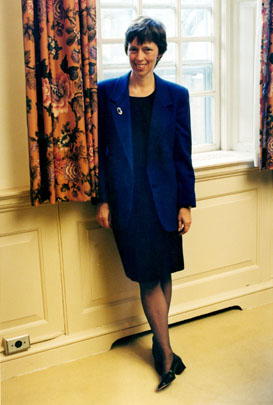The aging of America’s teachers

Today’s new teachers are as likely to be 40-year-old former lawyers or scientists with a five-week certification course behind them as they are to be 20-somethings fresh from teacher education programs.
And unlike generations of their predecessors, they have their eyes on advancement.
The face of teaching is changing, say researchers at the Harvard Graduate School of Education’s (GSE) Project on the Next Generation of Teachers, which surveyed first- and second-year teachers in New Jersey. And if schools are going to meet the unprecedented demand for new teachers – 2.2 million in the next decade – they need to change, too.
Susan Moore Johnson, Pforzheimer Professor of Education in Learning and Teaching and director of the Project on the Next Generation of Teachers, says the study’s findings challenge the common perception of a new teacher as “a 22-year-old, fresh, enthusiastic, can-do type who will tolerate any poor working conditions.” Instead, the researchers found that 46 percent of the new teachers in New Jersey had entered teaching from other careers. Their average age was 33, and almost a quarter of the midcareer entrants were over 40.
Also changing, Johnson and her colleagues found, is the notion of the career teacher, the classroom teacher who teaches generations of students and finishes his career exactly the way he started it. Although more than 90 percent of the first-career teachers in the New Jersey study said they expected a lifelong career in education, over two-fifths (43 percent) of them stated that they hoped to move on from classroom teaching into other positions in education. Of the midcareer entrants, nearly one-fifth (19 percent) expected to leave the classroom for curriculum development, administration, or some other nonteaching position in education.
Johnson says the research sounds a wake-up call for the nation’s schools. “Given the crisis-level teacher shortage that many districts are already experiencing, we need to provide the support and opportunities necessary to keep this diverse group of individuals in the classroom, teaching effectively,” she says.
Schools are meeting this need for more teachers by reaching out to midcareer teachers with incentives such as signing bonuses and accelerated certification programs. While these measures are effective up to a point, says Johnson, schools need to shift their resources toward retaining these teachers. The large number of midcareer teachers – valued in the classroom for their rich content knowledge – pose “serious challenges for the schools if they are going to retain these people and if those new teachers are going to do a good job while they are there,” Johnson says.
“They have expectations . . . they bring from business or law or engineering or journalism that many schools don’t meet – that they’ll have the materials they need to do their work, that they’ll get oriented to the technology, to their colleagues, to the space,” she adds.
Indeed, Johnson and Susan Kardos and Edward Liu, advanced doctoral students at GSE and research assistants on the project, tell of a new high school math teacher who had come from a job in the space industry. Frustrated by lack of support or even basic materials, the teacher left her urban school for a suburban district with better resources. Urban schools, with their high rate of teachers who flee for better-resourced suburban districts, are particularly hard-hit by the teacher shortage.
While signing bonuses and other incentives may entice new teachers to the profession, it’s their experience at the school and in the classroom that determines whether or not they’ll stay. “What kind of interactions they have with their colleagues, what kind of support they get from their principal, what kind of mentoring they get, if any, the frequency of classroom observation” are all factors that inform a teachers’ decision to stay at a school, says Kardos.
The high percentage of teachers who hope to move out of classroom teaching into other education careers is also cause for concern, says Johnson. “Currently there aren’t many other kinds of jobs available within education,” she says, noting that positions for principals, curriculum developers, and literacy specialists are in short supply. Schools have not been successful in providing varied and vertical career paths – taken for granted in most professions – for teachers. “A teacher is a teacher is a teacher, no matter how long you’ve been teaching,” Johnson says.
That could and should change, she says, by creating formalized coaching and mentoring positions for more experienced teachers. Not doing so, she says, “means that we’re not using the human capital effectively. We’re losing a lot of the talent and wisdom that experienced teachers have to offer.”
As the study continues, it will evaluate the impact of school cultures and decision-making structures on retention. The Project on the Next Generation of Teachers will conduct a follow-up survey in four additional states, although the researchers believe the results from New Jersey will be typical.
Before the study is finished, however, Johnson and her colleagues are sufficiently impressed with the results to release them so schools can use them immediately. “We believe that it’s very important for schools to realize that the kind of workplace, the kind of support, and that the kind of opportunities they provide to learn from other people and to teach other people about what they know – all of that is very important in whether schools are successful in retaining teachers,” she says.




